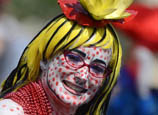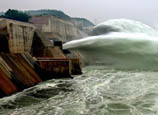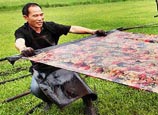
Neatly displayed in his living room, the fleet is divided into eight squadrons, each representing a milestone in the development of ships: the age of geographical discovery, the golden age of sail, ironclads, dreadnoughts, destroyers, submarines, aircraft carriers and stealth warships.
All the models are in a uniform 1/350 scale so it's easy to see how Columbus's Nina is so dramatically dwarfed by a modern nuclear-powered aircraft carrier such as the USS Enterprise (his model around 1 meter long).
Miniature world
Closer inspection reveals an astonishing, miniature world - the detailed portholes and guns on the sailing ships, the railings and rigging with correct thinness on the dreadnoughts, the vivid carrier-based aircraft with flashing canopies, the realistic paintwork with proper "rusting" and weathering. What is extraordinary is that he created this miniature showcase entirely with ordinary magnifying glasses.
Sparkling with traces of historical accuracy and decades of craftsmanship in modeling, Wu's fleet was actually born as a pastime only nine years ago of a very domestic need - he wanted to adorn his new apartment. It was only after retirement in 2009 that he could devote more time to his hobby. But it would not have been possible without his life experience and a seafaring dream that went back to his childhood.
The walls in his apartment, decorated with his oil paintings, wood engravings and Chinese ink paintings, reveal his career as a versatile artist. He used to work as a newspaper illustrator and then a designing manager in a home decorating company. His artistic skill is evident in his models - the realistically textured wooden hulls of the sailing ships and the rust on the steel hulls were all realized with oil paint.
"Scale modeling is half art and half technology," says Wu.
For the technology part, he referred to his short encounter with modeling when he was a schoolboy. At that time model ships and aircraft could only be made from scratch.
He would start a project by laying the keel, exactly like building a real ship. Although his dream of being a shipbuilder came to an abrupt end due to political upheaval, he easily adapted his modeling skills to his later job as an interior designer, which in turn contributes to the construction of his current fleet.
"Making models can be a hobby or a sport, but what's more intriguing is its cultural and social implication," says Wu.
The broad view he acquired through his interests in painting, music, photography, history and his extensive travels in Europe has not only given birth to his unique fleet but also made him consider the relationship between modeling and national power.
"A country's level of industrial development is positively correlated to its model building population because the precision in making models is exactly what is needed in building the real thing," he says. "Germany and Japan are very good examples."


















 6 golden pythons get new home at Chimelong Safari Park in Guangzhou
6 golden pythons get new home at Chimelong Safari Park in Guangzhou


![]()
